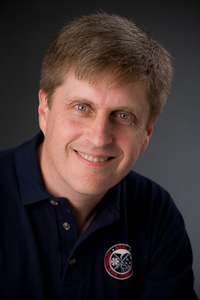
Meteorologists are scientists who study and work in the field of meteorology. Those who study meteorological phenomena are meteorologists in research while those using mathematical models and knowledge to prepare daily weather forecast are called weather forecasters or operational meteorologists.

NEXRAD or Nexrad is a network of 160 high-resolution S-band Doppler weather radars operated by the National Weather Service (NWS), an agency of the National Oceanic and Atmospheric Administration (NOAA) within the United States Department of Commerce, the Federal Aviation Administration (FAA) within the Department of Transportation, and the U.S. Air Force within the Department of Defense. Its technical name is WSR-88D.
The National Severe Storms Laboratory (NSSL) is a National Oceanic and Atmospheric Administration (NOAA) weather research laboratory under the Office of Oceanic and Atmospheric Research. It is one of seven NOAA Research Laboratories (RLs).

The National Weather Center (NWC), on the campus of the University of Oklahoma, is a confederation of federal, state, and academic organizations that work together to better understand events that take place in Earth's atmosphere over a wide range of time and space scales. The NWC partners give equal attention to applying that understanding to the development of improved observation, analysis, assimilation, display, and prediction systems. The National Weather Center also has expertise in local and regional climate, numerical modeling, hydrology, and weather radar. Members of the NWC work with a wide range of federal, state, and local government agencies to help reduce loss of life and property to hazardous weather, ensure wise use of water resources, and enhance agricultural production. They also work with private sector partners to develop new applications of weather and regional climate information that provide competitive advantage in the marketplace.
The Enhanced Fujita scale rates the intensity of tornadoes in some countries, including the United States and Canada, based on the damage they cause.
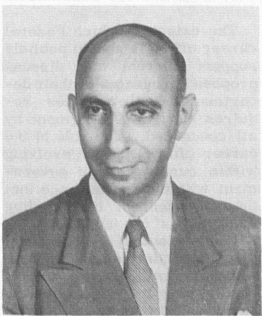
Helmut Erich Landsberg (1906–1985) was a noted and influential climatologist. He was born in Frankfurt, Germany, February 9, 1906 and died December 6, 1985 in Geneva, Switzerland while attending a meeting of the World Meteorological Organization. Landsberg was an important figure in meteorology and atmospheric science in education, public service and administration. He authored several notable works, particularly in the field of particulate matter and its influence on air pollution and human health. He is the first to write in English about the use of statistical analysis in the field of climatology and implemented such statistical analysis in aiding military operations during World War II. He received a number of significant honors during his life. Several honors are now bestowed in his name in recognition of his contributions to his field.
Neil Burgher Ward, American meteorologist, was the first scientific storm chaser, and second known storm chaser, developing ideas of thunderstorm and tornado structure and evolution as well as techniques for forecasting and intercept. He also was a pioneering developer of physical models of tornadoes, first at his home, then at the National Severe Storms Laboratory (NSSL). He significantly furthered understanding of atmospheric vortices, particularly the tornado.

The Verification of the Origins of Rotation in Tornadoes Experiment or VORTEX are field experiments that study tornadoes. VORTEX1 was the first time scientists completely researched the entire evolution of a tornado with an array of instrumentation, enabling a greater understanding of the processes involved with tornadogenesis. A violent tornado near Union City, Oklahoma was documented in its entirety by chasers of the Tornado Intercept Project (TIP) in 1973 and visual observations led to advancement in understanding of tornado structure and life cycles. VORTEX2 utilized enhanced technology allowing scientists to improve forecasting capabilities to improve advanced warnings to residents. VORTEX2 sought to elucidate how tornadoes form, how long they last and why they last that long, and what causes them to dissipate.

The European Severe Storms Laboratory (ESSL) conducts research on severe convective storms, tornados, heavy precipitation events and avalanches across Europe and the Mediterranean. It operates the widely consulted European Severe Weather Database (ESWD).
Edward Epstein was an American meteorologist who pioneered the use of statistical methods in weather forecasting and the development of ensemble forecasting techniques.

Roger M. Wakimoto is an atmospheric scientist specializing in research on mesoscale meteorology, particularly severe convective storms and radar meteorology. A former director of the National Center for Atmospheric Research (NCAR), Wakimoto in November 2012 was appointed as assistant director of the Directorate for Geosciences (GEO) of the National Science Foundation (NSF).
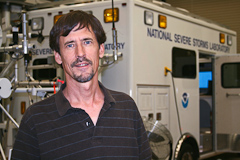
Erik Nels Rasmussen is an American meteorologist and leading expert on mesoscale meteorology, severe convective storms, forecasting of storms, and tornadogenesis. He was the field coordinator of the first of the VORTEX projects in 1994-1995 and a lead principal investigator for VORTEX2 from 2009-2010 and VORTEX-SE from 2016-2017, as well as involved in other smaller VORTEX offshoots and many field projects.
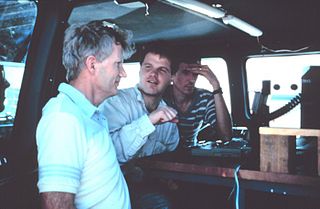
Robert Peter Davies-Jones is a British atmospheric scientist who substantially advanced understanding of supercell and tornado dynamics and of tornadogenesis. A theoretician, he utilized numerical simulations as well as storm chasing field investigations in his work as a longtime research meteorologist at the National Severe Storms Laboratory (NSSL) in Norman, Oklahoma.

Louis John Wicker is an American atmospheric scientist with expertise in numerical analysis, numerical simulation, and forecasts of severe convection and tornadoes. Doing storm chasing field research, Wicker deployed the TOtable Tornado Observatory (TOTO) and was in leadership roles in the VORTEX projects. He is also known for pioneering work simulating convection at the National Center for Supercomputing Applications (NCSA) at the University of Illinois at Urbana–Champaign (UIUC).

Adam James Clark is an American meteorologist at the Cooperative Institute for Mesoscale Meteorological Studies (CIMMS) and the National Severe Storms Laboratory (NSSL) recognized for contributions to numerical modeling of convection.
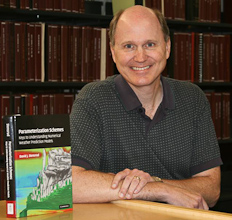
David Jonathan Stensrud is an American meteorologist recognized for numerical modeling and forecasting of hazardous synoptic and mesoscale weather and for incorporating new data into models.
David Owen Blanchard is an American meteorologist, photographer, and storm chaser. He was a significant collaborator in seminal research on tornadogenesis, specifically the importance of baroclinic boundaries, the rear-flank downdraft (RFD) and its thermodynamic characteristics.
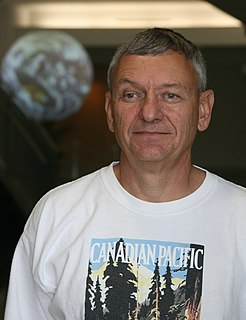
Donald W. Burgess is an American meteorologist who has made important contributions to understanding of severe convective storms, particularly tornadoes, radar observations and techniques, as well as to training other meteorologists. He was a radar operator during the first organized storm chasing expeditions by the University of Oklahoma (OU) in the early 1970s and participated in both the VORTEX projects.
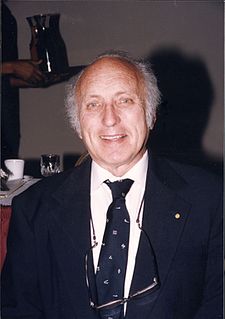
Edwin Kessler III was an American atmospheric scientist who oversaw the development of Doppler weather radar and was the first director of the National Severe Storms Laboratory (NSSL).

James F. "Jeff" Kimpel was an American atmospheric scientist with expertise on severe storms who was a provost of the University of Oklahoma (OU) and director of the National Severe Storms Laboratory (NSSL).
